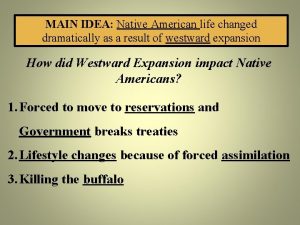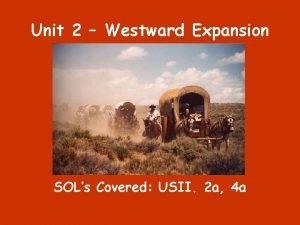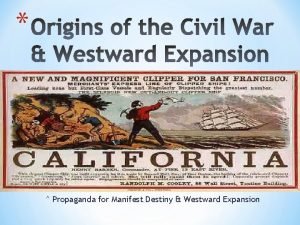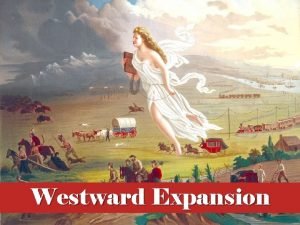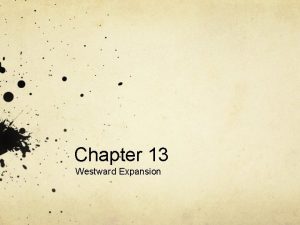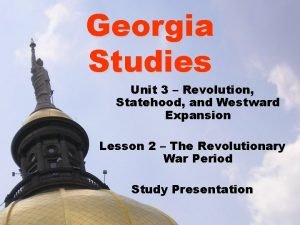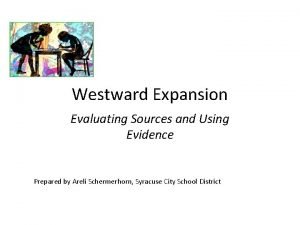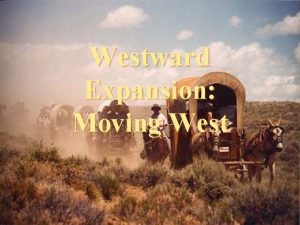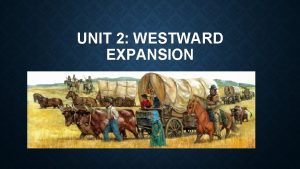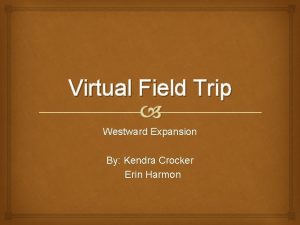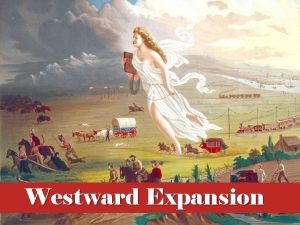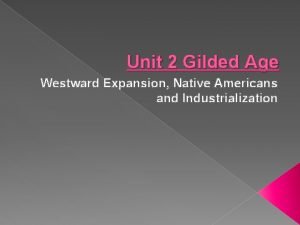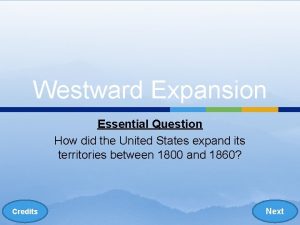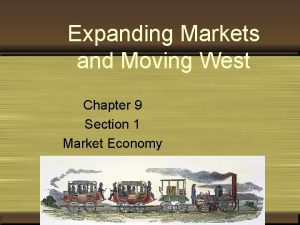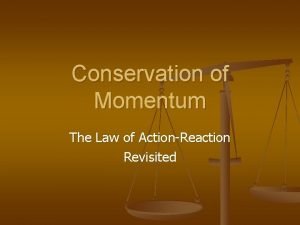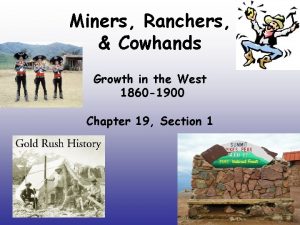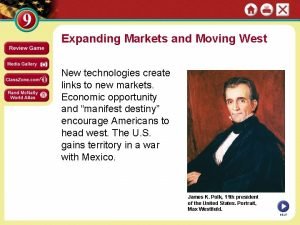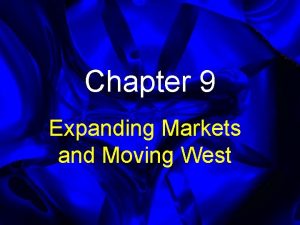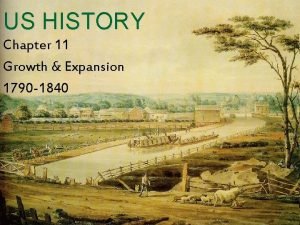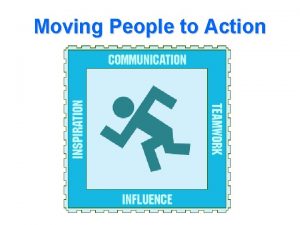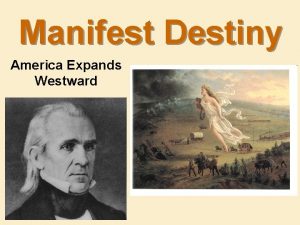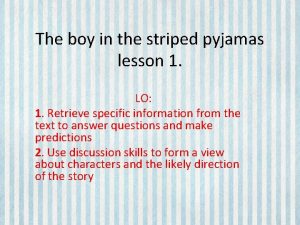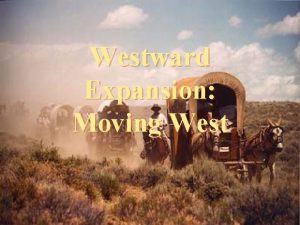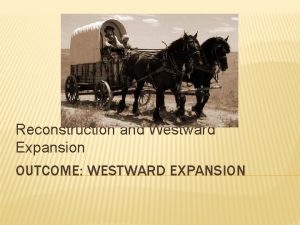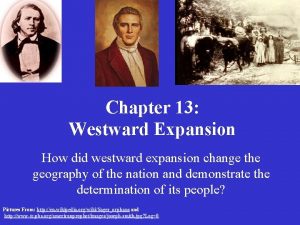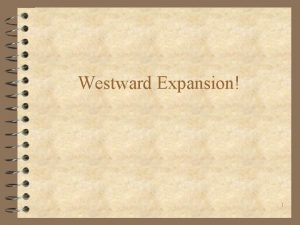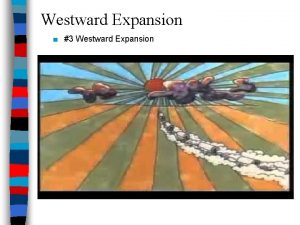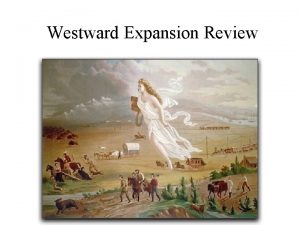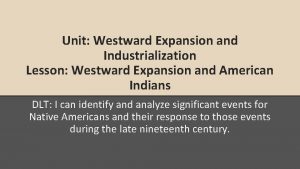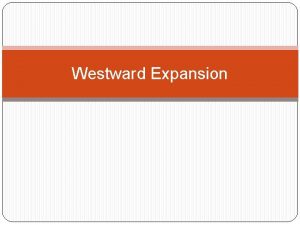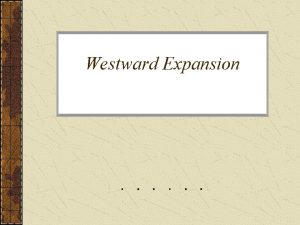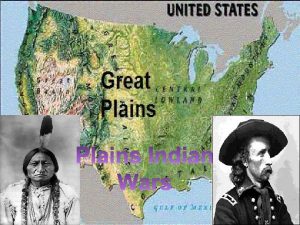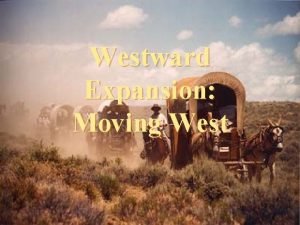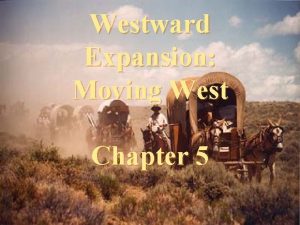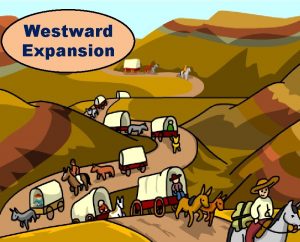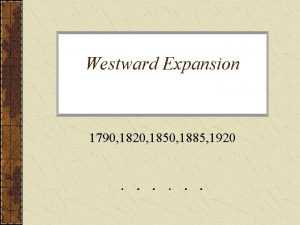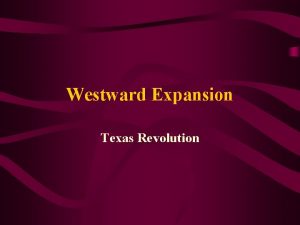Westward Expansion Moving West People Moved West for











































- Slides: 43

Westward Expansion: Moving West

People Moved West for Land n In the South, farmland was expensive n n Poor people could not buy their own land Sharecropping was how many poor whites and exslaves had to farm Blacks were mistreated – Black Codes In the west was “wide open” areas –especially the Great Plains where “only” some Indians lived

People Moved West to Make Money n n Gold and silver was discovered – drawing people who wanted to get rich quick Millions of buffalo lived on the Great Plains – easy to kill and hides worth money back east

People Moved West for Personal Reasons n Sense of adventure and freedom n Chance to start a new life – outlaws or in debt

Manifest Destiny n n Americans, stirred by their hunger for land the ideology of “Manifest Destiny, ” flocked to the new frontiers. Manifest Destiny means an obvious fate of the Untied States to grow and become powerful regardless of who or what was in their way – Indians, buffalo, Mexicans

Manifest Destiny Led to Conflicts n Conflicts between American settlers and Indian nations in the Southeast and the old Northwest resulted in fights with the Indians n n Indians eventualluy lost and were relocated to reservations Parts of the Southwest was owned by Mexico, which led to war

War for Texas Independence n n n American migration into Texas led to an armed revolt against Mexican rule Took place on October 2, 1835 – April 21, 1836 Famous battle at the Alamo, in which a band of Texans fought to the last man against a vastly superior force led by General Santa Ana Texas lost at the Alamo, but eventually won, forming their own country Later, Texas joined the Union.

Famous People in the War n n n James Bowie – Bowie knifed named after Davy Crockett – Famous explore Antonio López de Santa Anna – Mexican general

Video Summary n https: //www. youtube. com/watch? v=HVBm 3 y_ PMt. Y

Mexican American War n n n The United States fought Mexico in the Mexican-American War in the 1840 s This was due in large part the desire for Mexican held lands The American victory in the war led to the addition of an enormous territory that included the present-day states of California, Nevada, Utah, Arizona, and parts of Colorado, and New Mexico.

Impact on the American Indians n n n During this period of westward expansion, the settlers repeated wanted Indian land – leading to fights and wars The American Indians were repeatedly defeated in violent conflicts with settlers and soldiers and removed from their lands. Many atrocities

Trail of Tears n n n One of most famous is the Trail of Tears Cherokees and other tribes were removed from their homes in winter and rorced to march far away from their homes to Oklahoma Many died – old people, women, children Came through Missouri Many of us have Cherokee blood from those abandoned here

Indians fought back… n As Indians lost more and more land, they fought back – losing almost all their battles – and they did lose the war n n n Sandy Creek Massacre (1864) - Colorado Battle of Little Big Horn (1876) – Dakotas, Wyoming and Montana Battle of Wounded Knee (1890) – South Dakota

The Black Hills n n A treaty was signed between the U. S. government and Lakota leaders. The treaty gave the Black Hills reservation to the Lakota people forever.

Gold miners illegally rushed onto the reservation when gold was discovered.

The Battle of Little Bighorn George Custer was to defeat the Lakota and force them onto a new reservation. n To allow gold mining n

Crazy Horse helped lead the Lakota to victory at the Battle of Little Bighorn. George Custer and his men were all killed. This battle was known as “Custer’s Last Stand. ”

What then… n n The United States sent more soldiers to the Black Hills and forced the Lakota to a new reservation. The Black Hills were open to gold miners and settlers from the United States.

Why was the battle important? n n It was the biggest victory Native Americans ever won over United States forces. It led to the end of freedom for Native Americans of the Great Plains.

The Battle at Wounded Knee n n n The last major conflict between the United States and Native Americans occurred at Wounded Knee, South Dakota. Lakota families decided to leave their reservation. After being surrounded by U. S. soldiers, the Lakota decided to surrender.

Battlefield at Wounded Knee n n When the Lakota surrendered, someone fired a shot. About 300 Lakota were killed.

Reservations n n n Many forced to reservations – land supposed to be set aside for Indians Generally poor land, no hunting, not good for crops Indians often starved and died of disease

Gold and Silver Strikes The CA Gold Rush began in 1849, attracting thousands of gold hunters known as forty-niners.

Major "Strikes" in the California Gold Rush In 1852 the take for the year was $80 million ($1. 9 billion in 2005 dollars). Sutter's Mill/Coloma - Jan. 24, 1848 James Marshall kicked off the California gold rush when he spotted some pea-sized bits of gold in a mill raceway. The news brought thousands of prospectors to the area, but neither Marshall nor his employer John Sutter prospered from the find.

Gold and silver mines were discovered throughout the West. Thousands of miners from the U. S. , Europe, Mexico, and China flocked to the West. White and Chinese miners hoping to strike it rich during the California Gold Rush at Auburn Ravine in 1852.

The Homestead Act of 1862 • The Homestead Act gave public lands (lands owned by the national government) to American citizens

Homestead Act n n n Law signed by Lincoln in 1862 For a small fee a person could obtain 160 acres for free But not really free – were some rules n n n At least 21 years old or head of a family American citizen or immigrant filing for citizenship Build house a minimum size (12 feet by 14 feet) Live in house 6 months out of year Farm land 5 yrs in a row before ownership set 372, 000 new farms - 600, 000 land claims – 80 million acres


In the photos above, the blue square represents one acre.

Effects: • The Homestead Act helped poor families who could not afford land in the eastern states. • It gave unemployed workers a chance to find work on land of their own. Daniel Freeman Standing, Holding Gun, with Hatchet Tucked in Belt, The "first homesteader" to settle in Beatrice, Nebraska, 1863.

• Thousands of African-Americans moved west in 1879 in an effort to find a better life. • This was known as the “Exodus of 1879”, and the participants were called “Exodusters”.

End of the Buffalo n n n Buffalo were in the way of railroads and settlers so had to be removed Indians depended on buffalo – had to exterminate buffalo to help rid land of Indians Hides worth lots of money back east 25 million buffalo killed (1840 -1889) Replaced with cattle – and rise of the cowboy

Cowboys n n Cattle replaced the buffalo Cowboys collected cattle in Texas and moved them north where they could be shipped to the East

Cattle Drives and Rise of the Cattle Industry n After the Civil War, growing cities in the East increased their demand for beef. n Some cattle had gotten lose in Texas and during the war had been forgotten – so large herds developed and were available for the taking n Railroads had reached Kansas, where cattle could be shipped east n Texas ranchers began to drive herds of longhorns hundreds of miles north to the railroads, where they were shipped east.

· Cow towns developed near the railroads, offering cowhands hotels, saloons, and restaurants. Abilene, Kansas (late 1800’s)

End of the Cattle Drives n n The spread of farming, as well as harsh weather, destroyed the cattle boom by 1887. Cowboys moved to ranches, made possible by the invention of barbed wire

Barbed Wire Hundreds of miles of barbed wire were strung across the state in the 1880 s, forever changing the character of the frontier and bringing a measure of management to the cattle industry.

Transcontinental Railroad n n n n Transcontinental Railroad – To connect eastern states with the west Opened up the west Allowed cattle to be shipped west One of most important technological advances Lincoln signed law before Civil War Only after was it built Government had no money, so paid in land

Promontory Point, Utah . Central Pacific Railroad x Omaha, Nebraska . Union Pacific Railroad J j Sacramento, California · In 1863, two companies, the Union Pacific and the Central Pacific, began building the first transcontinental railroad.

Immigrant Workers Central Pacific approximately 90% of their workforce were Chinese immigrants · Labor was scarce due to the Union Pacific - hard, dangerous hired many work and low Irish pay. immigrants · Therefore, immigrant labor was used.

· The workers endured scorching deserts, blinding snowstorms, and blasted through mountains. Chinese railroad workers perform their duties in the snow.

Transcontinental Railroad Completed n n The Transcontinental Railroad Completed in May 10, 1869 at Promontory Point Utah. The railroads cut travel time west from six months to six days!

On May 10, 1869, a golden spike was hammered into a track joining the two tracks in Promontory Point, UT.
 Assimilation westward expansion
Assimilation westward expansion Homeland security
Homeland security Manifest destiny propaganda
Manifest destiny propaganda Westward expansion territories map
Westward expansion territories map American expansion westward/manifest destiny
American expansion westward/manifest destiny Essential questions for westward expansion
Essential questions for westward expansion Chapter 13 westward expansion
Chapter 13 westward expansion Great plains westward expansion
Great plains westward expansion Westward expansion vocabulary
Westward expansion vocabulary Unit 3 rev. statehood and westward expansion
Unit 3 rev. statehood and westward expansion Westward expansion
Westward expansion How did westward expansion increase sectional tensions
How did westward expansion increase sectional tensions Westward expansion vocabulary
Westward expansion vocabulary Westward expansion thesis statement
Westward expansion thesis statement Unit 2 westward expansion vocabulary
Unit 2 westward expansion vocabulary Westward expansion virtual field trip
Westward expansion virtual field trip Westward expansion essential questions
Westward expansion essential questions Westward expansion wagon
Westward expansion wagon Gilded age acrostic poem
Gilded age acrostic poem Westward expansion essential questions
Westward expansion essential questions Us territorial acquisitions map
Us territorial acquisitions map American historama lewis and clark
American historama lewis and clark Westward expansion lewis and clark
Westward expansion lewis and clark Gilded age westward expansion
Gilded age westward expansion Lesson 2 moving west
Lesson 2 moving west Chapter 9 expanding markets and moving west
Chapter 9 expanding markets and moving west Action-reaction and momentum conservation
Action-reaction and momentum conservation Moving west
Moving west Chapter 9 expanding markets and moving west
Chapter 9 expanding markets and moving west Expanding markets and moving west
Expanding markets and moving west Chapter 9 expanding markets and moving west
Chapter 9 expanding markets and moving west Chapter 11 growth and expansion
Chapter 11 growth and expansion Moving people to action
Moving people to action Emanuel leutze westward the course of empire
Emanuel leutze westward the course of empire World oldest age
World oldest age Satire literary device
Satire literary device Who moved my cheese lessons
Who moved my cheese lessons Who moved my cheese presentation
Who moved my cheese presentation Norwegians were most likely to migrate to the united states
Norwegians were most likely to migrate to the united states Since hanna moved away poem
Since hanna moved away poem Boy in the striped pajamas lesson plans
Boy in the striped pajamas lesson plans Elements are moved between minerals during metamorphism by:
Elements are moved between minerals during metamorphism by: Can you lend larry and me that literary cavalcade
Can you lend larry and me that literary cavalcade A lamp is moved from 30 cm to 90cm
A lamp is moved from 30 cm to 90cm
